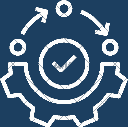
- ACE-Model
- Overview
- Stage 1: ACE-Core
- Stage 2: ACE-Box
- Stage 3: ACE-Apply
- …
- ACE-Model
- Overview
- Stage 1: ACE-Core
- Stage 2: ACE-Box
- Stage 3: ACE-Apply
- ACE-Model
- Overview
- Stage 1: ACE-Core
- Stage 2: ACE-Box
- Stage 3: ACE-Apply
- …
- ACE-Model
- Overview
- Stage 1: ACE-Core
- Stage 2: ACE-Box
- Stage 3: ACE-Apply
The ACE-Core
A 4-step methodology to create the foundations of any successful ACE project:
Comprehend > Operate > Refine > Engineer

1. Comprehend
Learn what makes up a control system, and how each component plays a role in achieving control.
(1.1) Core Principles of Control Systems
By the end of this section, learners will be able to:
- Distinguish between open-loop and closed-loop systems using block diagrams.
- Identify and describe the key elements of both open-loop and closed-loop control systems.
- Explain how each system functions (i.e., open-loop versus closed-loop) and the differences in their behaviour.
- Relate closed-loop control system configurations to engineering examples.

2. Operate
Discover how to operate a control system, from understanding system requirements to testing and validation.
(2.1) Control System Requirements
Formulate clear and measurable control system requirements based on a real-world engineering scenario, establishing the foundation for system design and validation.

(2.2) Operate a Control System using Physical Hardware or Virtual Lab
Configure and safely operate a control system using either physical hardware or a virtual lab environment, demonstrating practical competency.
(2.3) Validate Performance against Defined Requirements
Conduct structured testing (via hardware or simulation) to evaluate system behaviour and validate performance against defined requirements.

3. Refine
Discover the process of setting a control system up to achieve a set of requirements.
(3.1) Diagnose Performance Limitations in a Control System
Collect, analyse and present test data using insights to inform improvement strategies.
(3.2) Improve System Performance in-line with Specified Requirements
Refine controller parameters (tuning) and/or adjust system configuration based on test outcomes.
(3.3) Evaluate the Effectiveness of Tuning and/or Configuration Changes
Re-test and compare results against baseline performance and original requirements.

4. Engineer
Use mathematics to design control algorithms, from system requirements to testing and validation.
(4.1) Develop Mathematical Models of Dynamic Systems
Use system identification techniques, exploring both continuous-time and discrete-time representations.
(4.2) Digital Signal Processing Techniques
Filtering sensor noise, reject outliers, and enhance data quality to support robust control performance.
(4.3) Design and Tune PID Control Algorithms to Meet a Set of Requirement
Use the developed system models and filtered data, and implement the controller in hardware.
Advancing control engineering education through global collaboration
















